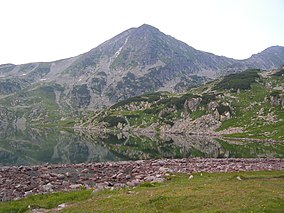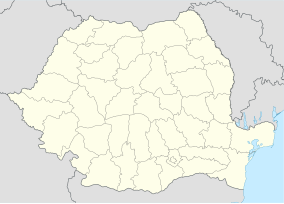Retezat National Park
| Retezat National Park | |
|---|---|
| Parcul Național Retezat | |
 Retezat Mountains, near camping site Bucura | |
Location within Romania | |
| Location | |
| Nearest city | Lupeni |
| Coordinates | 45°20′N 22°50′E / 45.34°N 22.83°E[1] |
| Area | 38047 hectares (94020 acres) |
| Established | 2000[2] |
| Website | retezat.ro |
The Retezat National Park (Romanian: Parcul Naţional Retezat) is a protected area (national park category II IUCN) located in the Retezat Mountains in Hunedoara county, Romania.[3]
History
The Retezat region has been a subject of scientific interest, particularly in regard to its flora, since at least the early 19th century.[4] During the 1930s, several scientific personalities like Alexandru Borza and Emil Racoviţă campaigned for the creation of nature reserves in the country.[5] In 1935, the Tătărescu government set aside 100 square kilometers of the Retezat Mountains, creating the country's first national park. It took four more years for legislation to be passed regarding the park's status, paving the way for all future protected areas of Romania.[5]
In 1979, UNESCO included the park in the Man and the Biosphere Program international network of biosphere reserves, while in 1993 it was included by the International Union for Conservation of Nature among its demonstration projects on sustainable rural development.[6] In 2008 it was granted the European Diploma of Protected Areas.[7]
Since the 1990s sheep grazing and logging activity have increased considerably, damaging the park's natural capital. In the 21st century Retezat has been the subject of several restoration and renaturation efforts.[8][9]
Description
Containing more than sixty peaks over 2,300 metres (7,500 ft) and over one hundred crystal clear deep glacier lakes, the Retezat Mountains are some of the most spectacular in the Carpathians.
Currently the park has 380.47 km2 (146.90 sq mi).[10] The area shelters one of Europe's last remaining intact old-growth forest and the continent's largest single area of pristine mixed forest. Vf. Peleaga, the highest peak of the Retezat Mountains, 2,509 metres (8,232 ft) is located in the park. The park also includes about eighty glacier lakes.

Flora and fauna
The flora consists of approximately 1,190 plant species, of which 130 have the "endangered" or "vulnerable" status. More than a third of Romania's flora can be found in this area.[9] Mountain pine and juniper habitats are dominant, with spruce and rhododendron also common.[9]
Wolves, brown bear, wild boar, Eurasian lynx, European wildcat, chamois, roe deer and red deer as well as small carnivore species such as Eurasian badger and Eurasian otter populate the park.
The Gemenele ("The Twins" in Romanian) scientific reserve is a strictly protected area of the park enclosing 1,800 hectares of intact old-growth forest.[6]
See also
References
- ^ eunis.eea.europa.eu - Retezat National Park (coords); retrieved on June 14, 2012
- ^ (in Romanian) cdep.ro - Legea Nr.5 din 6 martie 2000, publicată în Monitorul Oficial al României, Nr.152 din 12 aprilie 2000; retrieved on June 14, 2012
- ^ protectedplanet.net - Retezat National Park (location); retrieved on June 14, 2012
- ^ Coldea, Gheorghe; Cristea, Vasile (2022). "Chapter 2: History of Floristic and Vegetation Research". The Vascular Plant Communities of the Retezat National Park (Southern Carpathians). Geobotany Studies. Berlin: Springer Nature. pp. 11–14. ISBN 978-3-031-05618-5.
- ^ a b Guţă, Daniel (6 March 2018). "Savanţii care au transformat Retezatul în primul parc naţional al României: „În aceşti munţi vom sorbi aerul de libertate lăsat moştenire de Craiul Decebal"". Adevărul. Retrieved 22 August 2023.
- ^ a b IUCN (1995). "3.6 Retezat National Park, Romania". Best Practice for Conservation Planning in Rural Areas: Biological and Landscape Diversity in Central and Eastern Europe. Gland, Switzerland, and Cambridge, UK: IUCN. pp. 39–45. ISBN 978-2-8317-0286-5.
- ^ "Resolution CM/ResDip(2008)2 on the award of the European Diploma of Protected Areas to the Retezat National Park (Romania)". Council of Europe. 2 July 2008. Retrieved 22 August 2023.
- ^ Kiss, Imre; Alexa, Vasile (November 2014). "Ecological Restoration Activities for Long-Term Preservation of the Common Habitats in the Retezat National Park". Annals of the Faculty of Engineering Hunedoara - International Journal of Engineering. 13 (4): 213–216.
- ^ a b c Kiss, Imre; Alexa, Vasile (November 2014). "Renaturation Activities of Mountain Habitats with Creeping Mountain Pine Seedlings in Retezat National Park". Annals of the Faculty of Engineering Hunedoara - International Journal of Engineering. 12 (4): 353–358.
- ^ (in Romanian) apmhd.anpm.ro - Agenţia pentru Protecşia Mediului Hunedoara; retrieved on June 14, 2012
External links
- Official site
- Map of the Park
- Jiu Valley Portal - the home of the Official Jiu Valley City Websites and a gateway to the Retezat National Park and other destinations in the Transylvanian Alps
- Maps of the Retezat and other mountain ranges in the Transylvanian Alps
- Touristic Maps of the Retezat Mountains


